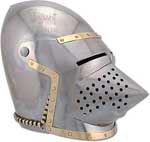Pig-Faced Bascinet
Pig-Faced Bascinet / Hounskull Helmet
 A hounskull, called in Germany a hundsgugel, was a form of steel helmet worn in Europe in the Middle Ages, almost invariably by knights and other mounted men-at-arms, from the middle of the 14th century until approximately 1420. It offered extensive protection for the wearer's face at the cost of some visibility, but its distinctive visor could be raised or lowered at will.
The visor swung up to uncover the wearer's face when he was not in combat, to grant him better visibility and unrestricted ventilation. This was accomplished in one of two ways. The most common form of visor in Central Europe was held on by a single hinge fastened to the center of the top of the visor, called a Klappviser. The other version had two pivot bolts on either side of the visor attaching it to the bascinet at the temples, and this was the most common form found in Southern, Western and Northwestern Europe.
A hounskull, called in Germany a hundsgugel, was a form of steel helmet worn in Europe in the Middle Ages, almost invariably by knights and other mounted men-at-arms, from the middle of the 14th century until approximately 1420. It offered extensive protection for the wearer's face at the cost of some visibility, but its distinctive visor could be raised or lowered at will.
The visor swung up to uncover the wearer's face when he was not in combat, to grant him better visibility and unrestricted ventilation. This was accomplished in one of two ways. The most common form of visor in Central Europe was held on by a single hinge fastened to the center of the top of the visor, called a Klappviser. The other version had two pivot bolts on either side of the visor attaching it to the bascinet at the temples, and this was the most common form found in Southern, Western and Northwestern Europe.
The wearer peered through two vision slots when the visor was lowered. The vision slots were either relatively flush with the visor, as was the custom in Western Europe, or elevated on mounts on the visor, as was commonly the case in Central Europe. The English term "hounskull" is considered by some historians to have been a derivation of the German term for the helmet, hundsgugel, meaning "hound's hood. The Victorian historians who described the helmet often referred to it as a "pig-faced" helmet, although that term was not used in the Medieval period.



